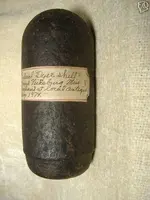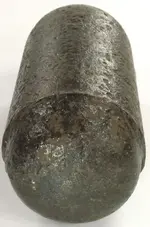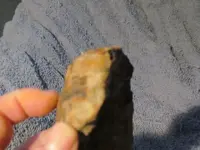After seeing the new photos, which are shot from different angles than the first set of photos, I must re-appraise that civil war artillery projectile fragment.
In finder Smokeythecat's first description of it, he said "cannon ball ID needed" (ball means a sphere)... and it looks like part of a sphere in the first set of photos. So, because of those photos, and because he was looking at the fragment in real-life and said "ball," I identified the type of cannonball it would be from. But in his new photos, it looks like it might be part of a cylindrical-bodied artillery shell, instead of from a spherical one. If so, that would explain why he said it is "3 inches in diameter" -- and in a followup reply he said "The top however, shows no evidence of a hole for a fuse."
In the new photos, it does look like part of a cylindrical-bodied shell. If that is correct, the only civil war artillery shell it matches up with is a yankee 3"-caliber Dyer Case-Shot... and the fragment is one side of its round-bottomed lower end, which is missing its zinc cup-sabot. I'd like to see photos of the fragment after all of the rust-crust gets cleaned off of it.
Here are two photos showing a 3"-caliber Dyer which is missing it zinc cup-sabot, and another photo which shows a sawed-in-half one that is missing the right-side half of the zinc sabot. If Smokeythecat's shell fragment is indeed from a cylindrical-bodied shell, not a spherical (ball-shaped) one, this is the specific type of shell I believe his fragment came from.
I should also mention... in another follow-up reply, Smokeythecat said he found the fragment at a farm near the Brandy Station (Virginia) battlefield -- and 3" Dyer shells have been dug at the Brandy Station battlefield.
Smokeythecat, please clean the rust-crust off the fragment's exterior, either by tapping it off with a hammer, or by using Electrolysis... and then post some photos of it. If it is from a 3" Dyer shell, it will have the little "step-down" near its bottom end, as seen in the photos of 3" Dyer shells missing their zinc sabot, below.
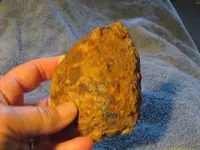
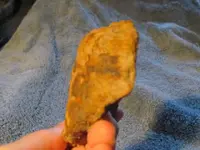
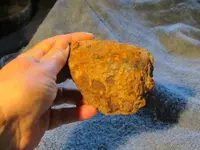 Please see the other post for another item found nearby.
Please see the other post for another item found nearby.

 Please see the other post for another item found nearby.
Please see the other post for another item found nearby.






